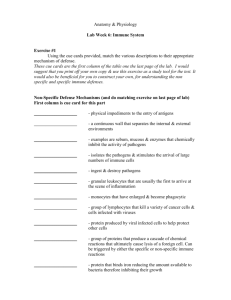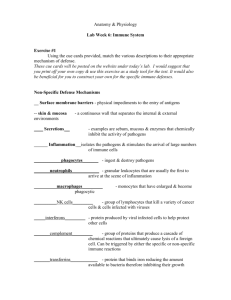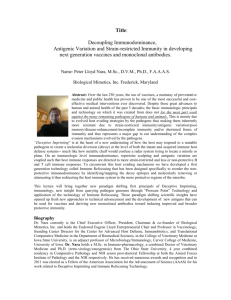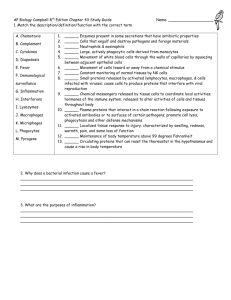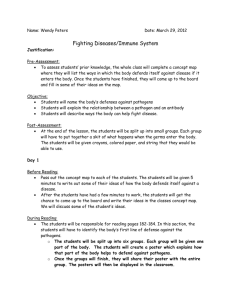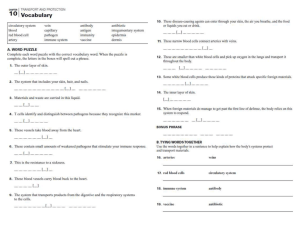Mr. B: Health 2 Chapter 23 Lesson 3 Notes Today's Objectives
advertisement
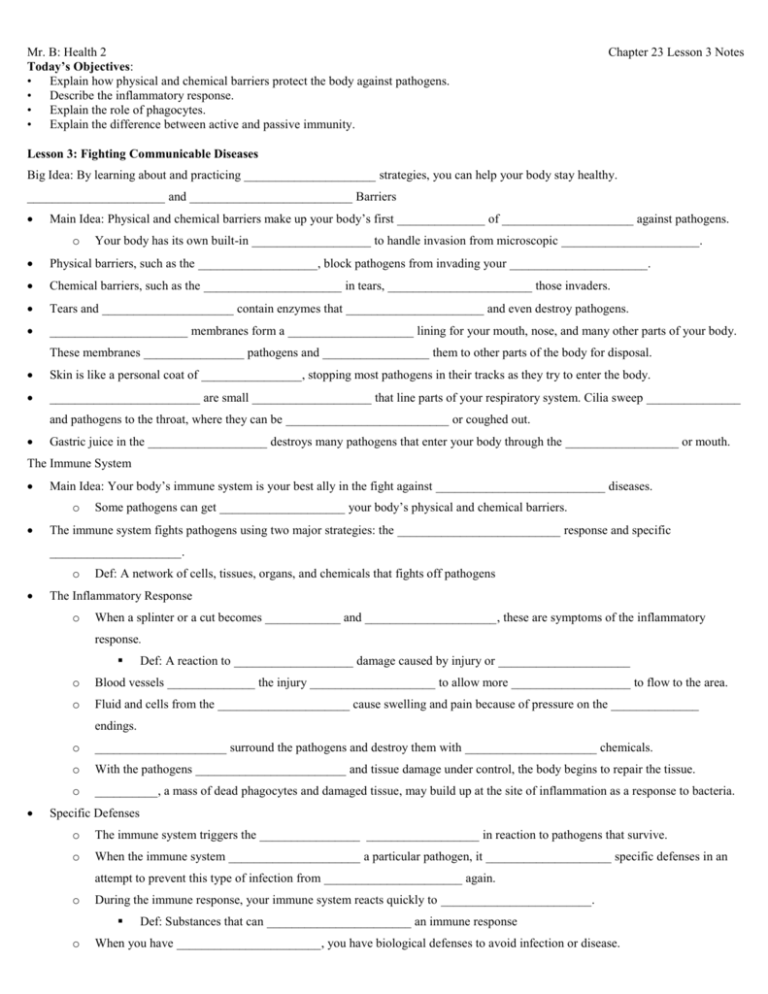
Mr. B: Health 2 Today’s Objectives: • Explain how physical and chemical barriers protect the body against pathogens. • Describe the inflammatory response. • Explain the role of phagocytes. • Explain the difference between active and passive immunity. Chapter 23 Lesson 3 Notes Lesson 3: Fighting Communicable Diseases Big Idea: By learning about and practicing _____________________ strategies, you can help your body stay healthy. ______________________ and __________________________ Barriers Main Idea: Physical and chemical barriers make up your body’s first ______________ of _____________________ against pathogens. o Your body has its own built-in ___________________ to handle invasion from microscopic ______________________. Physical barriers, such as the ___________________, block pathogens from invading your ______________________. Chemical barriers, such as the ______________________ in tears, _______________________ those invaders. Tears and _____________________ contain enzymes that ______________________ and even destroy pathogens. ______________________ membranes form a ____________________ lining for your mouth, nose, and many other parts of your body. These membranes ________________ pathogens and _________________ them to other parts of the body for disposal. Skin is like a personal coat of ________________, stopping most pathogens in their tracks as they try to enter the body. ________________________ are small ___________________ that line parts of your respiratory system. Cilia sweep _______________ and pathogens to the throat, where they can be __________________________ or coughed out. Gastric juice in the ___________________ destroys many pathogens that enter your body through the __________________ or mouth. The Immune System Main Idea: Your body’s immune system is your best ally in the fight against ___________________________ diseases. o Some pathogens can get ____________________ your body’s physical and chemical barriers. The immune system fights pathogens using two major strategies: the __________________________ response and specific _____________________. o Def: A network of cells, tissues, organs, and chemicals that fights off pathogens The Inflammatory Response o When a splinter or a cut becomes ____________ and _____________________, these are symptoms of the inflammatory response. Def: A reaction to ___________________ damage caused by injury or _____________________ o Blood vessels ______________ the injury ____________________ to allow more ___________________ to flow to the area. o Fluid and cells from the _____________________ cause swelling and pain because of pressure on the ______________ endings. o _____________________ surround the pathogens and destroy them with _____________________ chemicals. o With the pathogens ________________________ and tissue damage under control, the body begins to repair the tissue. o __________, a mass of dead phagocytes and damaged tissue, may build up at the site of inflammation as a response to bacteria. Specific Defenses o The immune system triggers the ________________ __________________ in reaction to pathogens that survive. o When the immune system _____________________ a particular pathogen, it ____________________ specific defenses in an attempt to prevent this type of infection from ______________________ again. o During the immune response, your immune system reacts quickly to ________________________. o Def: Substances that can _______________________ an immune response When you have _______________________, you have biological defenses to avoid infection or disease. Mr. B: Health 2 Chapter 23 Lesson 3 Notes Def: The state of being protected against a particular disease Lymphocytes o _____________________ play an important role in the immune response. There are two types of lymphocytes: _______ cells and __________ cells. Def: A specialized _________________ blood cell that coordinates and performs many functions of specific immunity T Cells o ________________ T Cells: Trigger the production of __________ cells and ______________ T cells o Killer T Cells: ___________________ and _____________________ infected body cells but do not attack the pathogens o ____________________ T Cells: Suppress, or “turn ____________,” helper T cells when the _________________ has been _____________________. B Cells o Each B cell is ________________________ to make one type of _____________________ that is specific to a certain _______________________________. o Def: A ____________________ that acts against a specific antigen The different purposes of antibodies include attaching to antigens to _________________ them for _________________________. destroying _________________________ pathogens. ______________________ viruses from entering body cells. Immune System Memory o Your immune system “__________________________” the antigens it has dealt with in the past. o When antigens _______________________ certain T cells and B cells, the cells become memory lymphocytes. o The lymphatic system is part of your immune system. It includes your ________________, lymph nodes, and a network of vessels, similar to blood vessels, that transport lymph, or tissue fluid. o Lymph nodes can become ____________________ when your body is fighting an infection because of the increased number of lymphocytes. If ________________________ lasts for three days, see your health care professional. o Lymphocytes are produced by lymph nodes. These nodes occur in groups and are concentrated in the _________________ and __________________, armpits, chest, abdomen, and groin. o Your immune system’s memory not only ___________________ invading pathogens. It also helps you develop immunity from certain diseases. o There are two types of immunity: ____________________ and _______________________. Active Immunity o Your body develops ______________________ active immunity when it is __________________ to invading pathogens. Artificially acquired active immunity is developed from a _______________________. Def: A preparation of dead or weakened pathogens that are introduced into the body to stimulate an immune response o For some diseases you only need to be vaccinated ________________________ in your life. o For other diseases you need to be vaccinated at regular __________________________. _________________________ Immunity o Passive immunity is ________________________, usually lasting only a few _______________ or ____________________. o Natural passive immunity occurs when antibodies pass from ________________ to child during ___________________ or while nursing. Mr. B: Health 2 Chapter 23 Lesson 3 Notes o ______________________ passive immunity happens when you receive an ________________________ prepared with _________________________ that are produced by an animal or a human immune to the disease. Prevention Strategies Main Idea: Strategies for preventing the spread of disease include _________________________ healthful behaviors, ______________________ diseases, and getting vaccinations. o Eating a ___________________________, well-balanced diet. o Get regular physical __________________________. o Wash your __________________________ frequently. o Handle food properly. o Avoid insect ___________________________. o Abstain from sexual contact. Tracking Reportable Diseases o ______________________, national, and global health __________________ track communicable diseases and predict where the diseases might strike next. o This information helps countries prepare and _______________________ their own prevention strategies. Vaccinations o ________________-virus vaccines are made from pathogens grown in __________________________. o ________________-virus vaccines are made from ____________________ pathogens. o ________________ are made from inactivated toxins from pathogens. o New and second-generation viruses are made with _________________________ altered cells. Immunizations for All o Vaccination reduces the number of people who are at ___________________ for a communicable disease. o That’s why it’s _______________________ to keep your immunizations up-to-date.

